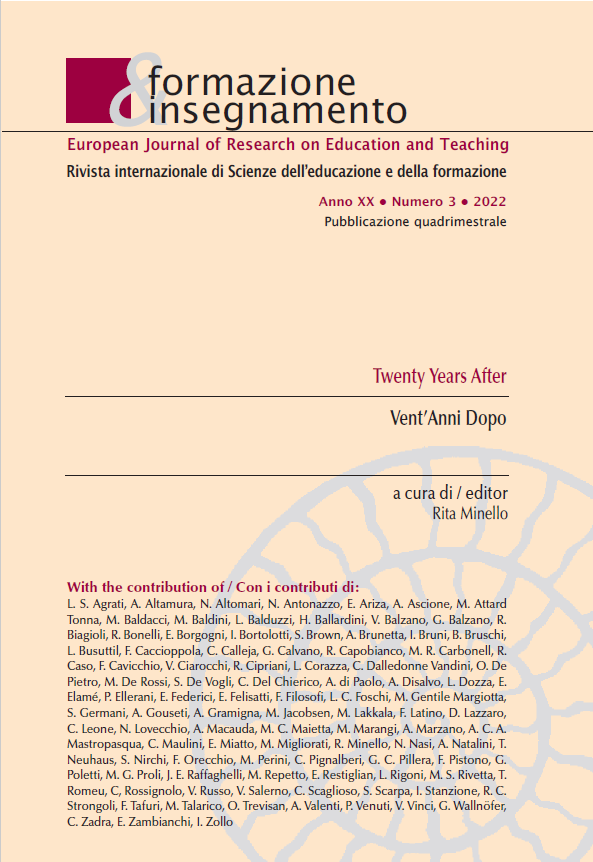The voice of the image: Theoretical considerations and practical experiences in the use of photography as analytical and practical tool in research and education
DOI:
https://doi.org/10.7346/-fei-XX-03-22_25Keywords:
Formative research, Visual Data, Phenomenological Pedagogical Science, PhotovoiceAbstract
This contribution explores a practice of educational research, the use of visual data, as a strategy for researching and reflecting on one’s own ways of perception and analysis of educational experiences. The use of images, as in the practice of photovoice, combined with descriptive captions and group discussions is a valuable tool for developing a reflective and open gaze and a pedagogical stance of a responsible educator-researcher in documenting and analysing educational experiences. Within educational research, visual data provide access to a participatory and active dimension and, accompanied by photo captions and discussions, enable theory and practice to be held together and the relationship between context, subjects and readers to be addressed, recognising the self-educational and awareness-raising effect for those who collect and write the data.
References
Allen, Q. (2012). Photographs and stories: Ethics, benefits and dilemmas of using participant photography with Black middle-class male youth. Qualitative research, 12(4), 443–458. http://dx.doi.org/10.1177/1468794111433088
Barthes, R. (2001). L’ovvio e l’ottuso. Einaudi.
Biffi, E. (2014). La ‘scrittura del caso’ come strategia di ricerca per le professioni educative. Encyclopaideia, 18(39), 117–134. https://dx.doi.org/10.6092/issn.1825-8670/4560
Bruzzone, D. (2022). L’esercizio dei sensi. Fenomenologia ed estetica della relazione educativa. FrancoAngeli.
Dozza, L. (1999). Il lavoro di gruppo tra relazione e conoscenza. La Nuova Italia.
Freire, P. (2002). La pedagogia degli oppressi. Ega. (Original work published 1970)
Gadamer, H. G. (1986). Verità e metodo. Bompiani.
Gobo, G., & Tota, A. (1994). Creatività e riflessività. Memorie di un Gruppo di Ricerca. In A. Melucci (Ed.), Creatività: Miti, Discorsi (pp. 206-223). Feltrinelli.
Lange, D. (1996). Photographs of a Lifetime. Millerton.
Leipert, B., & Smith, J. (2009). Using photovoice to explore rural older women’s health promotion needs and resources. Women’s health: Intersections of policy, research and practice, 135–150.
Liebenberg, L. (2018). Thinking critically about photovoice: Achieving empowerment and social change. International Journal of Qualitative Methods, 17(1), 1–9. https://doi.org/10.1177/1609406918757631
Marano, F. (2007). Camera etnografica: storie e teorie di antropologia visuale (Vol. 2). FrancoAngeli.
Mason, P. (2005). Visual data in applied qualitative research: Lessons from experience. Qualitative research, 5, 325-346. https://doi.org/10.1177/1468794105054458
Merleau-Ponty, M. (2003). Fenomenologia della percezione. Bompiani. (Opera originale 1976)
Merriam, S. B. (2003). Qualitative Research and Case Study Applications in Education. Jossey-Bass.
Mortari, L. (2016). Cultura della ricerca e pedagogia. Carocci. (Prima edizione 2007)
Orefice, P. (2006). La Ricerca Azione Partecipativa. Teoria e pratiche. Liguori.
Padgett, D. K., Smith, B. T., Derejko, K.-S., Henwood, B. F., & Tiderington, E. (2013). A picture is worth…? Photo elicitation interviewing with formerly homeless adults. Qualitative Health Research, 23(11), 1435–1444. https://doi.org/10.1177%2F1049732313507752
Pinto Minerva, F., & Vinella, M. (2012). La creatività a scuola. Laterza.
Reason, P. & Bradbury, H. (Eds.). (2008). The Sage Handbook of Action Research. Participative Inquiry and Practice (2nd ed.). Sage.
Rhodes, S. D., Cowan, C. A., Bardhoshi, G., & Pula, S. (2009). Photovoice as community-based participatory research: A qualitative review. American journal of health behavior, 33(6), 686–698. https://doi.org/10.5993/ajhb.33.6.6
Richard, V. M., & Lahman, M. K. (2015). Photo-elicitation: Reflexivity on method, analysis, and graphic portraits. International Journal of Research & Method in Education, 38(1), 3-22. https://doi.org/10.1080/1743727X.2013.843073
Ripamonti, E., & Boniforti, D. (2019). Dotarsi di strumenti per l’ascolto della comunità locale. Tecniche di collaborazione /1: Photovoice. Animazione Sociale, 1(324), 51–62.
Riva, M. G. (2007). La scrittura dei casi pedagogici come pratica della ricerca formativa. In D. Demetrio (Ed.), Per una pedagogia e una didattica della scrittura (pp. 409–423). Unicopli.
Rose, G. (2014). On the relation between ‘visual research methods’ and contemporary visual culture. Sociological Review, 62(1), 24–46. https://doi.org/10.1111/1467-954X.12109
Santinello, M. (2008). Quando la fotografia sviluppa empowerment. Il photovoice: il potere di una metodologia. Animazione sociale, 38(222), 75–80.
Santinello, M., Surian, A., & Gaboardi, M. (2022). Guida pratica al photovoice. Promuovere consapevolezza e partecipazione sociale. Erickson.
Sonntag, S. (1978). Sulla fotografia. Realtà e immagine nella nostra società. Einaudi.
Striano, M. (1999). Quando il pensiero si racconta. Meltemi.
Striano, M. (2020). La ricerca narrativa. In L. Mortari & L. Ghirotto (Eds.), Metodi per la ricerca educativa. (pp. 161–185). Carocci.
Sutton-Brown, C. A. (2014). Photovoice: A methodological guide. Photography and Culture, 7(2), 169–185. https://doi.org/10.2752/175145214X13999922103165
Tabucchi, A. (2010). Notturno indiano. Sellerio.
van Manen, M. (1990). Researching lived experience. Althouse Press.
van Manen, M. (1997). Researching lived experience: Human science for an action sensitive pedagogy (2nd ed). Althouse Press.
Waldenfels, B. (2008). Fenomenologia dell’estraneo. Raffaello Cortina. (Opera originale 2006)
Waldenfels, B. (2011). Estraneo, straniero, straordinario. Saggi di fenomenologia responsiva. Rosenberg & Sellier. Retrieved September 30, 2022, from http://www.openedition.org/6540
Wallnöfer, G., & Zadra, C. (2020). Disegnare con la luce. Il laboratorio di fotografia tra azione, interazione e riflessione. In L. Dozza (Ed.), Fare Rete per la Vita: idee e pratiche di Sviluppo Sostenibile. Zeroseiup.
Wang, C. (1999). Photovoice: A participatory action research strategy applied to women’s health. Journal of Women’s Health, 8(2), 185–192. https://doi.org/10.1089/jwh.1999.8.185
Wang, C. & Burris, M. A. (1994). Empowerment through photo novella: Portraits of participation, Health Education & Behavior, 21(2), 171–186. https://doi.org/10.1177/109019819402100204
Wang, C. & Burris, M. A. (1997). Photovoice: concept, methodology, and use for participatory needs assessment. Health Education & Behavior, 24(3), 369–387. https://doi.org/10.1177/109019819702400309
Wildemeersch, D. (2019). What Can We Learn from Art Practices? Exploring New Perspectives on Critical Engagement with Plurality and Difference in Community Art Education. The International Journal of Art & Design Education, 38(1), 168–181. https://doi.org/10.1111/jade.12168
Williams, B. E. (1987). Reaching adolescents through portraiture photography. Child and Youth Care Quarterly, 16(4), 241–248. https://doi.org/10.1007/BF01085827
Wittgenstein, L. (1999). Ricerche filosofiche. Einaudi.
Wittgenstein, L. (2007). Zettel: Lo spazio segregato della psicologia. Einaudi.
Downloads
Published
How to Cite
Issue
Section
License
Copyright (c) 2022 Cinzia Zadra, Gerwald Wallnöfer

This work is licensed under a Creative Commons Attribution 4.0 International License.
Formazione & insegnamento is distributed under Attribution 4.0 International (CC BY 4.0).
For further details, please refer to our Repository & Archiving Policy, as well as our Copyright & Licensing Terms.





